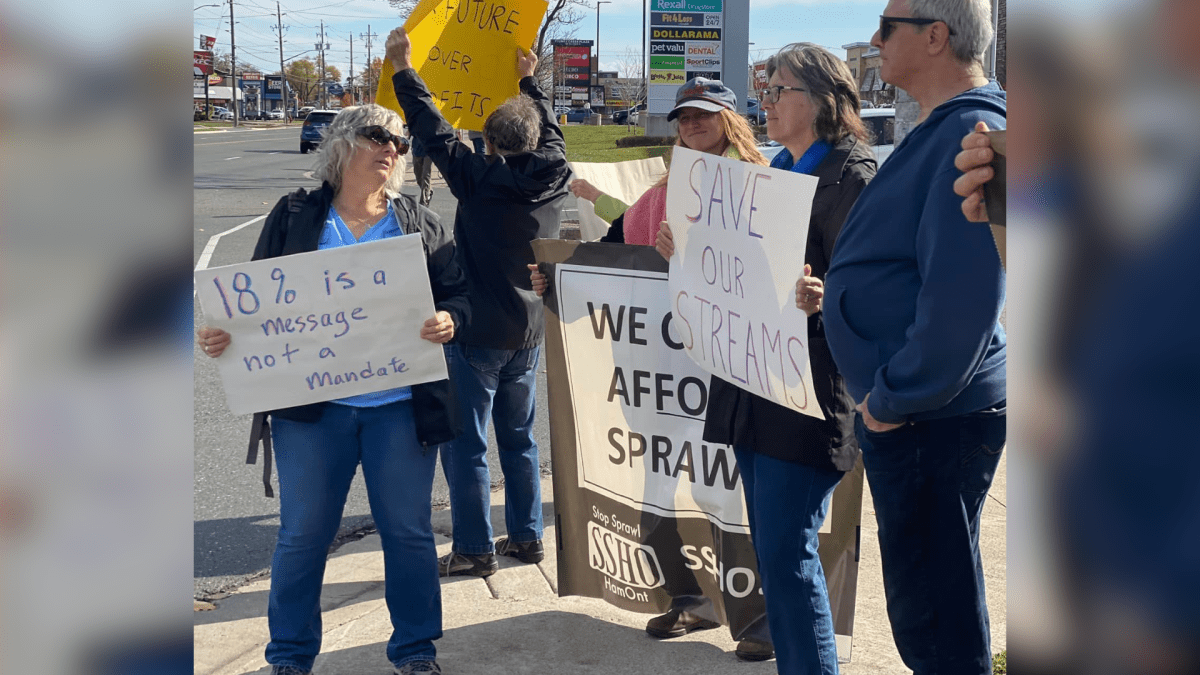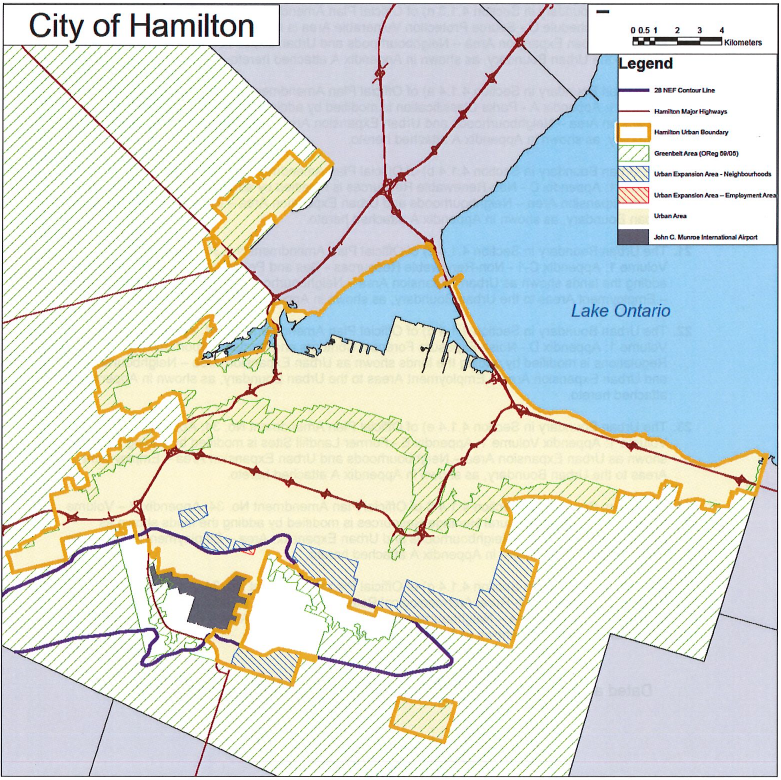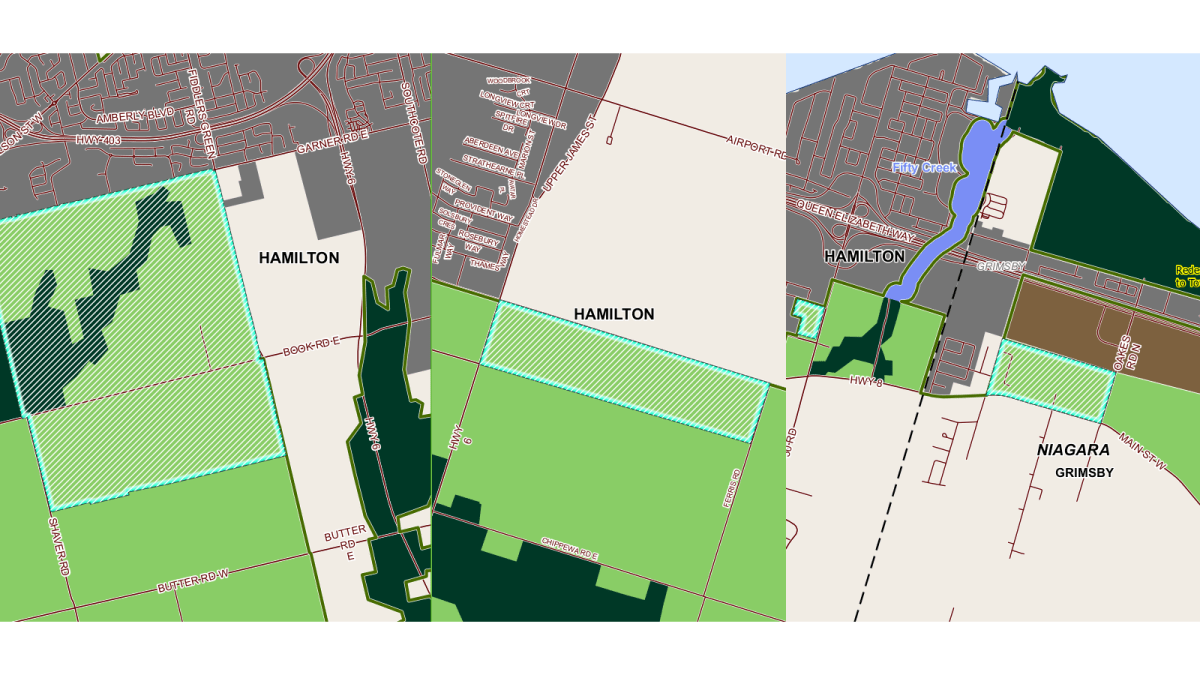Supporters of holding the line on Hamilton’s urban boundary were out in force on the weekend expressing outrage after the Ontario government rejected a freeze on urban expansion.

Demonstrators filled Stoney Creek streets on Sunday morning with messages for local MPPs about their displeasure with a Ford Government decision to make 2,200 hectares of the countryside available for new housing developments.
“Let us show our leaders that we will NOT be quiet, and that the safety and security of our food supply, environment, and affordable housing is of the upmost important to us,” protestors with Stop Sprawl Hamilton said in a social media post ahead of the rally.
The Ontario PC government’s ruling late Friday essentially overrides a November 2021 vote by Hamilton politicians to hold firm to the city’s urban boundary, and instead accommodate future population growth through a combination of infill and intensification.
The notice from housing minister Steve Clark and the Ministry of Municipal Affairs and Housing adopts a “rural plan” with amendments that push through a provincial growth plan targeting the development of so-called “white belt” and “Greenbelt” areas.
It also includes allowances for taller bulidings in communities like Binbrook and Ancaster — a stipulation not originally included in the province’s 2020 expansion estimates.
The initiative, based on estimates that Hamilton’s population will hit 820,000 by 2051, comes at the same time Ontario is proposing to remove land from the protected Greenbelt province-wide in order to build at least 50,000 new homes — contradicting a pledge made last year.
Incoming Mayor Andrea Horwath called that decision “very concerning” in a social media post and suggested the province’s action actually “increases costs” for municipalities and leaves Hamilton less able to build specific housing outlined in a previous local plan.
Ward 8 Coun. John-Paul Danko characterizes the province’s decision as a “betrayal,” and said the council’s 2021 decision was “one of the most important” since it was based on a survey with 18,000 replies, suggesting 90 per cent of Hamiltonians favoured holding the boundary.
“Not only did they decide they are going to build houses on every single available acre of farmland in the entire city, they also added parts of the greenbelt, which they said they would not do,” Danko told 900 CHML’s Good Morning Hamilton.

Get daily National news
Going forward, Danko said it appears there’s little that can be done about the province’s new plan, which primarily affects Ancaster, Stoney Creek and Glanbrook.
The decision cannot be appealed to a tribunal under Ontario law.
Councillors will look at potential recourse during a session with the city’s planning staff set for Nov. 29.
“That land has to be serviced,” Danko said.
“We have to have staff that would be assigned to the design and development of that land, and that is under the control of city council.”
Non-profit Environment Hamilton called the late Friday announcement a “bait and switch” with “dangerous environmental effects.”
They suggest the override will mean more urban sprawl generating “more car dependent, unaffordable neighborhoods.”
Meanwhile, the West End Homebuilder’s Association reacted favourably to the decision, with CEO Michael Collins-Williams suggesting the province’s plan modifications will increase housing supply of all types.
“Too many people are struggling to find an attainable home that meets their family’s needs,” Collins-Williams said in a release.
“It’s a complex problem that will require a range of solutions. One key element is increasing the supply and mix of housing.”
3 parcels of land in and around Hamilton set to be removed from Greenbelt
The province of Ontario says it will begin a 30-day consultation soon on its plan to remove about 7,400 acres in 15 different areas from the Greenbelt – two million acres of land that include some 700,000 acres of protected wetlands, grasslands, and forests.
The Ministry of Municipal Affairs and Housing is expected to seek public comment on the initiative, which will see the removal of three Hamilton properties in a countryside development affecting the Greater Toronto and Hamilton areas.
Targeted for development are the land located south of Garner Road West, a plot south of White Church Road East and a space between 331 and 339 Fifty Road near Oakes Road North.
Landowners are expected to develop housing plans for the new allocations “quickly” with construction beginning no later than 2025, according to minister Clark.
The aim is to build at least 50,000 homes in service of the government’s target of building 1.5 million homes in 10 years.
The CEO of the Ontario Home Builders Association (OHBA) says the province’s lofty goal means a 50 percent increase on his organizations best year, year over year, for the next ten years.
Luca Bucci insists developers that the OHBA represents are still subject to “environmental checks and balances” amid the latest decisions from the province and that “important environmental features” are expected in new homes.
“We still have to go through a process that is equipped with checks and balances to ensure that we are taking care of endangered species appropriately,” Bucci said.
“To make sure that we are not impacting floodplains, to make sure that we are building in a way that that allows the ecosystem within those environments to function properly.”
He went on to say the industry is also committed to producing the right balance of different housing types.
“Housing outside of the urban boundary … brought in are probably going to cater to a specific demographic,” said Bucci.
“But there is still a need to build that high density kind of focused development inside the urban boundary and primarily downtown along the line that’s going to be more appealing to young professionals.”














Comments